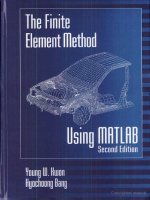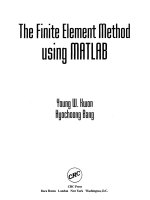The finite element method and applications in engineering using ANSYS
Bạn đang xem bản rút gọn của tài liệu. Xem và tải ngay bản đầy đủ của tài liệu tại đây (39.5 MB, 696 trang )
THE FINITE ELEMENT METHOD
AND APPLICATIONS IN
ENGINEERING USING ANSYS®
THE FINITE ELEMENT METHOD
AND APPLICATIONS IN
ENGINEERING USING ANSYS®
by
Erdogan Madenci
Ibrahim Guven
The University of Arizona
Springer
Erdogan Madenci
The University of Arizona
Ibrahim Guven
The University of Arizona
Library of Congress Control Number: 2005052017
ISBN-10: 0-387-28289-0
ISBN-13: 978-0387-28289-3
e-ISBN-10: 0-387-28290-4
e-ISBN-13: 978-0387-282909
© 2006 by Springer Science-nBusiness Media, LLC
All rights reserved. This work may not be translated or copied in whole or in part
without the written permission of the publisher (Springer Science + Business
Media, LLC, 233 Spring Street, New York, NY 10013, USA), except for brief
excerpts in connection with reviews or scholarly analysis. Use in connection with
any form of information storage and retrieval, electronic adaptation, computer
software, or by similar or dissimilar methodology now known or hereafter
developed is forbidden.
The use in this publication of trade names, trademarks, service marks and similar
terms, even if they are not identified as such, is not to be taken as an expression
of opinion as to whether or not they are subject to proprietary rights.
Printed in the United States of America
9876543
springer.com
PREFACE
The finite element method (FEM) has become a staple for predicting and
simulating the physical behavior of complex engineering systems. The
commercial finite element analysis (FEA) programs have gained common
acceptance among engineers in industry and researchers at universities and
government laboratories. Therefore, academic engineering departments
include graduate or undergraduate senior-level courses that cover not only
the theory of FEM but also its applications using the commercially available
FEA programs.
The goal of this book is to provide students with a theoretical and practical
knowledge of the finite element method and the skills required to analyze
engineering problems with ANSYS®, a commercially available FEA
program. This book, designed for seniors and first-year graduate students, as
well as practicing engineers, is introductory and self-contained in order to
minimize the need for additional reference material.
In addition to the fundamental topics in finite element methods, it presents
advanced topics concerning modeling and analysis with ANSYS®. These
topics are introduced through extensive examples in a step-by-step fashion
from various engineering disciplines. The book focuses on the use of
ANSYS® through both the Graphics User Interface (GUI) and the ANSYS®
Parametric Design Language (APDL). Furthermore, it includes a CD-ROM
with the "inpuf files for the example problems so that the students can
regenerate them on their own computers. Because of printing costs, the
printed figures and screen shots are all in gray scale. However, color
versions are provided on the accompanying CD-ROM.
Chapter 1 provides an introduction to the concept of FEM. In Chapter 2, the
analysis capabilities and fundamentals of ANSYS®, as well as practical
modeling considerations, are presented. The fundamentals of discretization
and approximation functions are presented in Chapter 3. The modeling techniques and details of mesh generation in ANSYS® are presented in Chapter
4. Steps for obtaining solutions and reviews of results are presented in
Chapter 5. In Chapter 6, the derivation of finite element equations based on
the method of weighted residuals and principle of minimum potential energy
vi
FEM WITH ANSYS®
is explained and demonstrated through example problems. The use of
commands and APDL and the development of macro files are presented in
Chapter 7. In Chapter 8, example problems on linear structural analysis are
worked out in detail in a step-by-step fashion. The example problems related
to heat transfer and moisture diffusion are demonstrated in Chapter 9.
Nonlinear structural problems are presented in Chapter 10. Advanced topics
concerning submodeling, substructuring, interaction with external files, and
modification of ANSYS®-GUI are presented in Chapter 11.
There are more than 40 example problems considered in this book; solutions
to most of these problems using ANSYS® are demonstrated using GUI in a
step-by-step fashion. The remaining problems are demonstrated using the
APDL. However, the steps taken in either GUI- or APDL-based solutions
may not be the optimum/shortest possible way. Considering the steps
involved in obtaining solutions to engineering problems (e.g., model
generation, meshing, solution options, etc.), there exist many different
routes to achieve the same solution. Therefore, the authors strongly encourage the students/engineers to experiment with modifications to the analysis
steps presented in this book.
We are greatly indebted to Connie Spencer for her invaluable efforts in typing, editing, and assisting with each detail associated with the completion of
this book. Also, we appreciate the contributions made by Dr. Atila Barut,
Mr. Erkan Oterkus, Ms. Abigail Agwai, Mr. Manabendra Das, and Mr.
Bahattin Kilic in the solution of the example problems. The permission
provided by ANSYS, Inc. to print the screen shots is also appreciated.
TABLE OF CONTENTS
PREFACE
LIST OF PROBLEMS SOLVED
1
INTRODUCTION
LI
1.2
1.3
1.4
2
Concept
Nodes
Elements
Direct Approach
1.4.1 Linear Spring
1.4.2 Heat Flow
1.4.3 Assembly of the Global System of Equations
1.4.4 Solution of the Global System of Equations
1.4.5 Boundary Conditions
V
xiii
1
1
3
4
5
5
6
8
12
13
FUNDAMENTALS OF ANSYS
15
2.1
2.2
15
16
16
18
18
19
25
26
27
27
27
27
27
28
28
28
28
2.3
2.4
2.5
Useful Definitions
Before an ANSYS Session
2.2.1 Analysis Discipline
2.2.2 Time Dependence
2.2.3 Nonlinearity
2.2.4 Practical Modeling Considerations
Organization of ANSYS Software
ANSYS Analysis Approach
2.4.1 ANSYS Preprocessor
2.4.2 ANSYS Solution Processor
2.4.3 ANSYS General Postprocessor
2.4.4 ANSYS Time History Postprocessor
ANSYS File Structure
2.5.1 Database File
2.5.2 Log File
2.5.3 ErrorFile
2.5.4 Results Files
viii
FEM WITH ANSYS^
2.6
2.7
3
29
30
31
32
32
32
32
32
33
33
33
35
FUNDAMENTALS OF DISCRETIZATION
37
3.1
3.2
3.3
37
37
43
43
43
43
43
51
54
3.4
3.5
3.6
3.7
4
Description of ANSYS Menus and Windows
2.6.1 Utility Menu
2.6.2 Main Menu
2.6.3 Toolbar
2.6.4 Input Field
2.6.5 Graphics Window
2.6.6 Output Window
Using the ANSYS Help System
2.7.1 Help Contents
2.7.2 Help Index
2.7.3 Search in Help
2.7.4 Verification Manual
Local and Global Numbering
Approximation Functions
Coordinate Systems
3.3.1 Generalized Coordinates
3.3.2 Global Coordinates
3.3.3 Local Coordinates
3.3.4 Natural Coordinates
Shape Functions
3.4.1 Linear Line Element with Two Nodes
3.4.2 Quadratic Line Element with Three Nodes:
Centroidal Coordinate
3.4.3 Linear Triangular Element with Three Nodes:
Global Coordinate
3.4.4 Quadratic Triangular Element with Six Nodes
3.4.5 Linear Quadrilateral Element with Four Nodes:
Centroidal Coordinate
Isoparametric Elements: Curved Boundaries
Numerical Evaluation of Integrals
3.6.1 Line Integrals
3.6.2 Triangular Area Integrals
3.6.3 Quadrilateral Area Integrals
Problems
56
58
59
62
64
68
68
72
75
78
ANSYS PREPROCESSOR
83
4.1
4.2
83
83
84
Fundamentals of Modeling
Modeling Operations
4.2.1 Title
TABLE OF CONTENTS
4.2.2
4.2.3
4.2.4
4.2.5
4.2.6
5
ix
Elements
Real Constants
Material Properties
Element Attributes
Interaction with the Graphics Window:
Picking Entities
4.2.7 Coordinate Systems
4.2.8 Working Plane
4.3 Solid Modeling
4.3.1 Bottom-up Approach: Entities
4.3.2 Top-down Approach: Primitives
4.4 Boolean Operators
4.4.1 Adding
4.4.2 Subtracting
4.4.3 Overlap
4.4.4 Gluing
4.4.5 Dividing
4.5 Additional Operations
4.5.1 Extrusion and Sweeping
4.5.2 Moving and Copying
4.5.3 Keeping/Deleting Original Entities
4.5.4 Listing Entities
4.5.5 Deleting Entities
4.6 Viewing a Model
4.6.1 Plotting: Pan, Zoom, and Rotate Functions
4.6.2 Plotting/Listing Entities
4.6.3 Numbers in the Graphics Window
4.7 Meshing
4.7.1 Automatic Meshing
4.7.2 Manipulation of the Mesh
4.8 Selecting and Components
4.8.1 Selecting Operations
4.8.2 Components
96
99
102
105
106
112
118
118
120
120
121
121
124
124
128
128
130
130
131
131
134
134
134
135
141
144
144
148
ANSYS SOLUTION AND POSTPROCESSING
149
5.1
5.2
149
150
150
153
154
154
Overview
Solution
5.2.1 Analysis Options/Solution Controls
5.2.2 Boundary Conditions
5.2.3 Initial Conditions
5.2.4 Body Loads
85
89
92
96
X
FEM WITH ANSYS®
5.3
5.4
6
,
154
158
160
160
160
161
163
167
170
170
FINITE ELEMENT EQUATIONS
187
6.1
187
6.2
6.3
7
5.2.5 Solution in Single and Multiple Load Steps
5.2.6 Failure to Obtain Solution
Postprocessing
5.3.1 General Postprocessor
5.3.2 Time History Postprocessor
5.3.3 Read Results
5.3.4 Plot Results
5.3.5 Element Tables
5.3.6 List Results
Example: One-dimensional Transient Heat Transfer
Method of Weighted Residuals
6.1.1 Example: One-dimensional Differential Equation
with Line Elements
6.1.2 Example: Two-dimensional Differential Equation
with Linear Triangular Elements
6.1.3 Example: Two-dimensional Differential Equation
with Linear Quadrilateral Elements
Principle of Minimum Potential Energy
6.2.1 Example: One-dimensional Analysis with
Line Elements
6.2.2 Two-dimensional Structural Analysis
Problems
189
197
216
235
242
248
289
USE OF COMMANDS IN ANSYS
297
7.1
297
298
304
307
309
314
317
317
318
321
322
324
325
326
7.2
7.3
7.4
7.5
7.6
7.7
Basic ANSYS Commands
7.1.1 Operators and Functions
7.1.2 Defining Parameters
A Typical Input File
Selecting Operations
Extracting Information from ANSYS
Programming with ANSYS
7.5.1 DO Loops
7.5.2 IF Statements
7.5.3 /OUTPUT and *VWRITE Commands
Macro Files
Useful Resources
7.7.1 Using the Log File for Programming
7.7.2 Using the Verification Problems for Programming
TABLE OF CONTENTS
8
LINEAR STRUCTURAL ANALYSIS
329
8.1
329
329
337
342
346
373
403
412
421
433
434
444
459
8.2
8.3
8.4
8.5
9
xi
Static Analysis
8.L1 Trusses
8.1.2 Beams
8.1.3 Three-dimensional Problems
8.1.4 Two-dimensional Idealizations
8.1.5 Plates and Shells
Linear Buckling Analysis
Thermomechanical Analysis
Fracture Mechanics Analysis
Dynamic Analysis
8.5.1 Modal Analysis
8.5.2 Harmonic Analysis
8.5.3 Transient Analysis
LINEAR ANALYSIS OF FIELD PROBLEMS
477
9.1
Heat Transfer Problems
9.1.1 Steady-state Analysis
9.1.2 Transient Analysis
9.1.3 Radiation Analysis
Moisture Diffusion
477
478
520
543
549
10 NONLINEAR STRUCTURAL ANALYSIS
565
9.2
10.1 Geometric Nonlinearity
10.1.1 Large Deformation Analysis of a Plate
10.1.2 Post-buckling Analysis of a Plate with a Hole
10.2 Material Nonlinearity
10.2.1 Plastic Deformation of an Aluminum Sphere
10.2.2 Plastic Deformation of an Aluminum Cylinder
10.2.3 Stress Analysis of a Reinforced Viscoelastic
Cylinder
10.2.4 Viscoplasticity Analysis of a Eutectic Solder
Cylinder
10.2.5 Combined Plasticity and Creep
10.3 Contact
10.3.1 Contact Analysis of a Block Dropping on a Beam
10.3.2 Simulation of a Nano-indentation Test
569
570
573
578
579
583
589
592
599
605
607
613
xii
FEM WITH ANSYS®
11 ADVANCED TOPICS IN ANSYS
11.1
11.2
11.3
11.4
Coupled Degrees of Freedom
Constraint Equations
Submodeling
Substructuring: Superelements
11.4.1 Generation Pass
11.4.2 Use Pass
11.4.3 Expansion Pass
11.5 Interacting with External Files
11.5.1 Reading an Input File
11.5.2 Writing Data to External ASCII Files
11.5.3 Executing an External File
11.5.4 Modifying ANSYS Results
11.6 Modifying the ANSYS GUI
11.6.1 GUI Development Demonstration
11.6.2 GUI Modification for Obtaining a Random
Load Profile
11.6.3 Function Block for Selecting Elements Using
a Pick Menu
621
621
624
629
636
638
644
646
647
647
648
652
654
654
662
671
675
REFERENCES
679
INDEX
681
LIST OF PROBLEMS SOLVED
ANSYS Solution of a Two-dimensional Differential Equation
with Linear Triangular Elements
211
ANS YS Solution of a Two-dimensional Differential Equation
with Linear Quadrilateral Elements
230
Plane Stress Analysis with Linear Triangular Elements
264
Plane Stress Analysis with Linear Quadrilateral Isoparametric
Elements
284
Elongation of a Bar Under Its Own Weight Using Truss Elements
330
Analysis of a Truss Structure with Symmetry
333
Analysis of a Slit Ring
337
Elongation of a Bar Under Its Own Weight Using 3-D Elements
342
Plane Stress Analysis of a Plate with a Circular Hole
346
Plane Stress Analysis of a Composite Plate Under Axial Tension
355
Plane Strain Analysis of a Bi-material Cylindrical Pressure Vessel
Under Internal Pressure
Deformation of a Bar Due to Its Own Weight Using 2-D
Axisymmetric Elements
Analysis of a Circular Plate Pushed Down by a Piston Head
359
366
Using 2-D Axisymmetric Elements
368
Static Analysis of a Bracket Using Shell Elements
373
Analysis of a Circular Plate Pushed Down by a Piston Head
Using Solid Brick and Shell Elements
383
xiv
FEM WITH ANSYS®
Analysis of an Axisymmetric Shell with Internal Pressure Using
Shell Elements
391
Analysis of a Layered Composite Plate Using Shell Elements
397
Linear Buckling Analysis of a Plate
403
Thermomechanical Analysis of an Electronic Package
412
Fracture Mechanics Analysis of a Strip with an Inclined
Edge Crack
421
Modal Analysis of a Bracket
434
Vibration Analysis of an Automobile Suspension System
438
Harmonic Analysis of a Bracket
444
Harmonic Analysis of a Guitar String
453
Dynamic Analysis of a Bracket
460
Impact Loading on a Beam
465
Dynamic Analysis of a 4-bar Linkage
471
Heat Transfer Analysis of a Tank/Pipe Assembly
478
Heat Transfer Analysis of a Window Assembly
499
Transient Thermomechanical Analysis of an Electronic Package
522
Transient Thermomechanical Analysis of a Welded Joint
532
Radiation Heat Transfer Analysis of a Conical Fin
543
Moisture Diffusion Analysis of an Electronic Package
549
Large Deformation Analysis of a Plate
570
Postbuckling Analysis of a Plate with a Hole
573
Plastic Deformation of an Aluminum Sphere
579
LIST OF PROBLEMS SOLVED
xv
Plastic Deformation of an Aluminum Cylinder
583
Stress Analysis of a Reinforced Viscoelastic Cylinder
589
Viscoplasticity Analysis of a Eutectic Solder Cylinder
592
Combined Plasticity and Creep Analysis of a Eutectic
Solder Cylinder
599
Contact Analysis of a Block Dropping on a Beam
607
Simulation of a Nano-indentation Test
613
Analysis of a Sandwich Panel Using Constraint Equations
624
Submodeling Analysis of a Square Plate with a Circular Hole
629
Substructuring Analysis of an Electronic Package
636
GUI Development Demonstration
662
Chapter 1
INTRODUCTION
1.1 Concept
The Finite Element Analysis (FEA) method, originally introduced by Turner
et al. (1956), is a powerful computational technique for approximate solutions to a variety of "real-world" engineering problems having complex
domains subjected to general boundary conditions. FEA has become an
essential step in the design or modeling of a physical phenomenon in various engineering disciplines. A physical phenomenon usually occurs in a
continuum of matter (solid, liquid, or gas) involving several field variables.
The field variables vary from point to point, thus possessing an infinite
number of solutions in the domain. Within the scope of this book, a
continuum with a known boundary is called a domain.
The basis of FEA relies on the decomposition of the domain into a finite
number of subdomains (elements) for which the systematic approximate
solution is constructed by applying the variational or weighted residual
methods. In effect, FEA reduces the problem to that of a finite number of
unknowns by dividing the domain into elements and by expressing the
unknown field variable in terms of the assumed approximating functions
within each element. These functions (also called interpolation functions)
are defined in terms of the values of the field variables at specific points,
referred to as nodes. Nodes are usually located along the element boundaries, and they connect adjacent elements.
The ability to discretize the irregular domains with finite elements makes the
method a valuable and practical analysis tool for the solution of boundary,
initial, and eigenvalue problems arising in various engineering disciplines.
Since its inception, many technical papers and books have appeared on the
development and application of FEA. The books by Desai and Abel (1971),
Oden (1972), Gallagher (1975), Huebner (1975), Bathe and Wilson (1976),
Ziekiewicz (1977), Cook (1981), and Bathe (1996) have influenced the
current state of FEA. Representative common engineering problems and
their corresponding FEA discretizations are illustrated in Fig. 1.1.
FEM WITH ANSYS®
Tfum
/
symmetry line
elastic plate
symmetry , ."diodes
line\ / V /
, -\,.i . ambient
(steam 1
^^^':-V•'t.-
temp.
steam_J^'^-j:i^gj^^g„t3
insulation
temp.
steam pipe
r_i-i-i-,
symmetry line
stream line
/ l/./^y\
III:
symmetry
line ^^ r^'^'l-Hlh
i-lxf/yih.y],
M
"^^^^'•A'l'f'u
M
^•^-^^-r*! 1
"HRn'iT 1 1 t 1
symmetiy line
flow around pipe
Fig. 1,1
FEA representation of practical engineering problems.
The finite element analysis method requires the following major steps:
• Discretization of the domain into a finite number of subdomains (elements).
• Selection of interpolation functions.
• Development of the element matrix for the subdomain (element).
• Assembly of the element matrices for each subdomain to obtain the global
matrix for the entire domain,
• Imposition of the boundary conditions.
• Solution of equations.
• Additional computations (if desired).
There are three main approaches to constructing an approximate solution
based on the concept of FEA:
Direct Approach: This approach is used for relatively simple problems,
and it usually serves as a means to explain the concept of FEA and its
important steps (discussed in Sec. 1.4).
INTRODUCTION
3
Weighted Residuals: This is a versatile method, allowing the application of FEA to problems whose functional cannot be constructed. This
approach directly utilizes the governing differential equations, such as
those of heat transfer and fluid mechanics (discussed in Sec. 6.1).
Variational Approach: This approach relies on the calculus of variations, which involves extremizing a functional. This functional corresponds to the potential energy in structural mechanics (discussed in Sec.
6.2).
In matrix notation, the global system of equations can be cast into
Ku = F
(1.1)
where K is the system stiffness matrix, u is the vector of unknowns, and
F is the force vector. Depending on the nature of the problem, K may be
dependent on u , i.e., K = K(u) and F may be time dependent, i.e.,
F = F(0.
1.2 Nodes
As shown in Fig. 1.2, the transformation of the practical engineering problem to a mathematical representation is achieved by discretizing the domain
of interest into elements (subdomains). These elements are connected to
each other by their "common" nodes. A node specifies the coordinate
location in space where degrees of freedom and actions of the physical
problem exist. The nodal unknown(s) in the matrix system of equations
represents one (or more) of the primary field variables. Nodal variables
assigned to an element are called the degrees of freedom of the element.
The common nodes shown in Fig. 1.2 provide continuity for the nodal
variables (degrees of freedom). Degrees of freedom (DOF) of a node are
dictated by the physical nature of the problem and the element type. Table
1.1 presents the DOF and corresponding ''forces" used in FEA for different
physical problems.
i^i.y^)
{x,.y<)
(?^5.y,)
common nodes
{^A.yd
common
nodes
Fig. 1.2
common
nodes
Division of a domain into subdomains (elements).
FEM WITH ANSYS^
Table 1.1 Degrees of freedom and force vectors in
FEA for different engineering disciplines.
Discipline
Structural/solids
Heat conduction
Acoustic fluid
Potential flow
General flows
Electrostatics
Magnetostatics
DOF
Displacement
Temperature
Displacement potential
Pressure
Velocity
Electric potential
Magnetic potential
Force Vector
Mechanical forces
Heat flux
Particle velocity
Particle velocity
Fluxes
Charge density
Magnetic intensity
1.3 Elements
Depending on the geometry and the physical nature of the problem, the
domain of interest can be discretized by employing line, area, or volume
elements. Some of the common elements in FEA are shown in Fig. 1.3.
Each element, identified by an element number, is defined by a specific
sequence of global node numbers. The specific sequence (usually counterclockwise) is based on the node numbering at the element level. The node
numbering sequence for the elements shown in Fig. 1.4 are presented in
Table 1. 2.
z
z
tetrahedral
z
right prism
volume elements
irregular hexahedal
Fig, 1.3 Description of line, area, and volume elements with node
numbers at the element level.
INTRODUCTION
global node
number
6
""^ 5
4
local node
number
3
^^ 2
3
3'
element 2
local node ^
number'
Fig. 1.4
Discretization of a domain: element and node numbering.
Table 1.2 Description of numbering at the element level.
Element
Number
1
2
3
Nodel
Node 2
Node 3
Node 4
1
3
4
2
4
5
6
6
6
7
2
1.4 Direct Approach
Although the direct approach is suitable for simple problems, it involves
each fundamental step of a typical finite element analysis. Therefore, this
approach is demonstrated by considering a linear spring system and heat
flow in a one-dimensional (1-D) domain.
1.4.1
Linear Spring
As shown in Fig. 1.5, a linear spring with stiffness k has two nodes. Each
node is subjected to axial loads of /j and /2 , resulting in displacements of
Wj and ^2 ^^ their defined positive directions.
Subjected to these nodal forces, the resulting deformation of the spring
becomes
(1.2)
W = Wj - ^ 2
2
1
AA/WV
-O-
Fig. 1.5 Free-body diagram of a linear spring element.
6
FEM WITH ANSYS®
which is related to the force acting on the spring by
/i = to = /:(«! -W2)
(1-3)
The equiUbrium of forces requires that
/2=-/i
(1.4)
which yields
f2=k{u2-u^)
(1.5)
Combining Eq. (1.3) and (1.5) and rewriting the resulting equations in
matrix form yield
k
-k
-k
k
or k^V^Uf(^)
(1.6)
in which u^^^ is the vector of nodal unknowns representing displacement
and k^^^ and f^^^ are referred to as the element characteristic (stiffness)
matrix and element right-hand-side (force) vector, respectively. The superscript {e) denotes the element numbered as ' e '.
The stiffness matrix can be expressed in indicial form as /:••'ie)
k^^^ - klf^
(1.7)
where the subscripts / and j (/,7=1,2) are the row and the column
numbers. The coefficients, kjf^, may be interpreted as the force required at
node / to produce a unit displacement at node j while all the other nodes
are fixed.
1,4.2
Heat Flow
Uniform heat flow through the thickness of a domain whose in-plane
dimensions are long in comparison to its thickness can be considered as a
one-dimensional analysis. The cross section of such a domain is shown in
Fig. 1.6. In accordance with Fourier's Law, the rate of heat flow per unit
area in the x -direction can be written as
q = -kA^
ax
(1.8)
INTRODUCTION
e.
qi
Fig. 1.6 One-dimensional heat flow.
where A is the area normal to the heat flow, 6 is the temperature, and k is
the coefficient of thermal conductivity. For constant k , Eq. (1.8) can be
rewritten as
q--kA
(1.9)
L
in which A^ = ^2~^i denotes the temperature drop across the thickness
denoted by L of the domain.
As illustrated in Fig. 1.6, the nodal flux (heat flow entering a node) at Node
1 becomes
(1.10)
The balance of the heat flux requires that
q2=-q\
(1.11)
92 = - ^ ( ^ 1 - ^ 2 )
(1.12)
which yields
Combining Eq. (1.10) and (1.12) and rewriting the resulting equations in
matrix form yield
kA 1
L -1
-1
1
WW
KJ U2.
or k^^V^UqW
(1.13)
8
FEM WITH ANSYS®
in which 9^^^ is the vector of nodal unknowns representing temperature and
k^^^ and q^^^ are referred to as the element characteristic matrix and
element right-hand-side vector, respectively.
1.4.3
Assembly of the Global System of Equations
Modeling an engineering problem with finite elements requires the assembly
of element characteristic (stiffness) matrices and element right-hand-side
(force) vectors, leading to the global system of equations
Ku = F
(1.14)
in which K is the assembly of element characteristic matrices, referred to
as the global system matrix and F is the assembly of element right-handside vectors, referred to as the global right-hand-side (force) vector. The
vector of nodal unknowns is represented by u .
The global system matrix, K ^ can be obtained from the "expanded"
element coefficient matrices, k^^^, by summation in the form
E
K = 2k^^>
(1.15)
in which the parameter E denotes the total number of elements. The
''expanded" element characteristic matrices are the same size as the global
system matrix but have rows and columns of zeros corresponding to the
nodes not associated with element (e). The size of the global system matrix
is dictated by the highest number among the global node numbers.
Similarly, the global right-hand-side vector, F , can be obtained from the
''expanded" element coefficient vectors, f ^^^, by summation in the form
E
F = ^f^^^
(1.16)
e=l
The "expanded" element right-hand-side vectors are the same size as the
global right-hand-side vector but have rows of zeros corresponding to the
nodes not associated with element {e). The size of the global right-hand-side
vector is also dictated by the highest number among the global node
numbers.
INTRODUCTION
9
The explicit steps in the construction of the global system matrix and the
global right-hand-side-vector are explained by considering the system of
linear springs shown in Fig. 1.7. Associated with element (e), the element
equations for a spring given by Eq. (1.6) are rewritten as
M)
M)
^22
I f(^)
Ml
(1.17)
I f (^)
hie) _ ae) _ _Ue)
(e)
in which k 11
and '^12
The subscripts used in
' 99 —
"'^2\
" '^
Eq. (1.17) correspond to Node 1 and Node 2, the local node numbers of
element {e). The global node numbers specifying the connectivity among
the elements for this system of springs is shown in Fig. 1.7, and the
connectivity information is tabulated in Table 1.3.
^F
Fig.
1.7 System of linear springs (top) and corresponding
FEA model (bottom).
Table 1.3
Table of connectivity.
Element
Number
1
Local Node
Numbering
1
2
Global Node
Numbering
1
2
2
1
2
2
3
3
1
2
2
3
4
1
2
3
4
10
FEM WITH ANSYS^
In accordance with Eq. (1.15), the size of the global system matrix is (4x4)
and the specific contribution from each element is captured as
E i
la i
r
''12
Element 1:
"•22 J a
^ -
Element 2:
^21
H
0
olS
"21
"22
0
0 P = k(i)
0
0
0
0
0
0
'*^12
A2)
''22 .
i
0
0
"n
"l2
0
0
"21
"22
0
L0
0
0
0
E i
i
i
0
0
0
0
0
"ll
"l2
0
i.,(3)
0
"21
"22
0
0
0
0
0
i
0
HI
i
i
0
0
0
0
0
0
0
0
0
0
"ll
"l2
L^
0
"21
'^11
i
Element 4: hi
^^21
i
"12
s
0
r 0
1^-
"22 ^
0 i
IV
0
1|i
^11 _
• —
i
%
^^21
.
0 Ji
i i
r 0
"12
Element 3:
hi
s
i i
i 0
(1.18)
IE
p.k(^)
i
Ji
•
E
IE
P_k(4)
i"
(1.21)
J0
Performing their assemb ly leacIs to
4
K = ^ k ( ^ U k ( H k ( 2 ) + k ( 3 ) ^ ^ (4)
«=i
or
(1.22)









